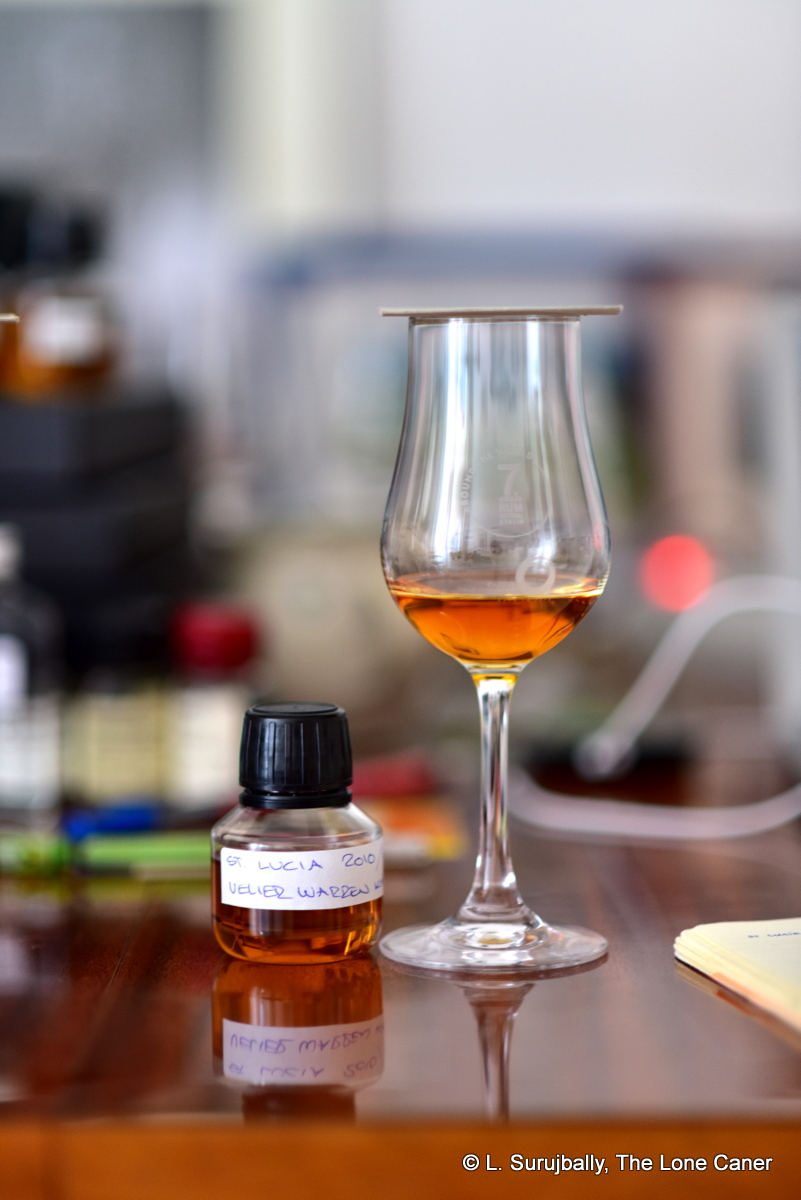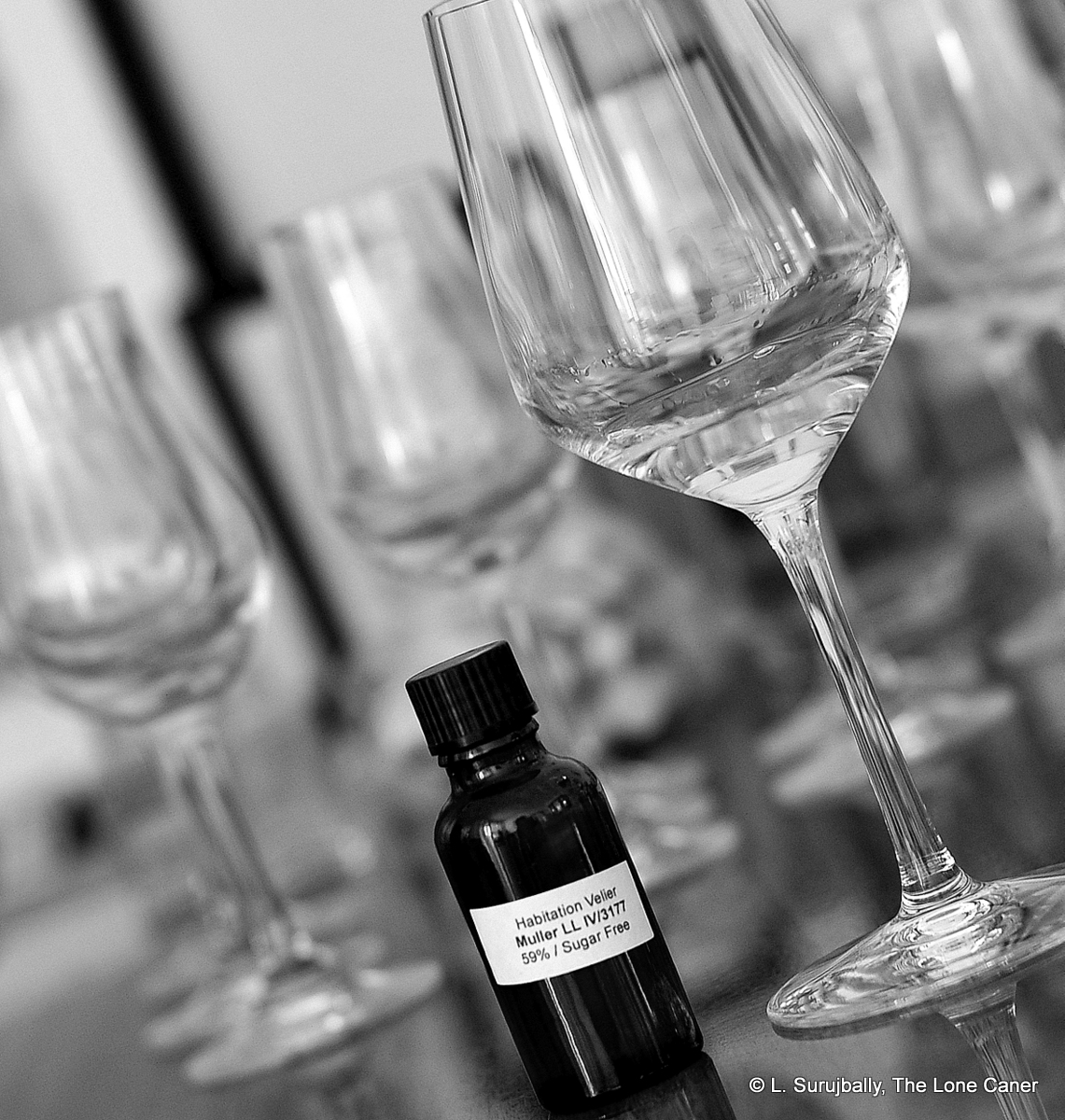The “Pagos” rum from Hampden — all 1200 bottles of the release — is another one of that storied estate’s experiments involving Luca Gargano, whose company has distribution rights to their rums, and who is known for tweaking things in odd directions just to see what comes out at the other end (and if you doubt that, just visit the NRJ quartet or the EMB rums which are about as non-commercial as it’s possible to get). Unusually for Hampden, this isn’t a multi-bottle series, but a one-off release of a single type, though it is my understanding that there may (will?) be others in years to come.
Luca was hinting about the Pagos (the word means “cru” in Jerez) and talking it up at masterclasses in various ‘fests around Europe in 2022, and indeed it was available for the proles to try at both Paris’s WhiskyLive and London’s UK Rumfest before going on sale later that year. The key takeaway is that it was completely aged for around 3-4 years in one of some forty 500-litre butts sourced from a Bodega called Lustau in SW Spain close to Cadiz, which Velier distributes. The butts held Pedro Ximenez and Oloroso for a few years and can therefore be said to have been influenced with and by better sherry, for longer, than far too many such barrels used around the rum and whisky industry which have some cheap plonk dropped in to them for a short time and then sold around as “seasoned.” The quality of the sherry and the length of time in the barrel does make a difference…as this rum shows.1
 So after all the visions and daydreams and desires to make a rum version of Macallan (which is not now that strength which in old days moved earth and heaven, I posit, but never mind), what came out the other end was a long-fermentation pot-still Jamaican rum fully aged in these butts for the aforementioned 3-4 years, issued at a nice and firm 52% and sporting an ester count 2 that places it at the very top end of LROK territory, and edging close to HLCF…my own personal sweet spot for Hampden rums.
So after all the visions and daydreams and desires to make a rum version of Macallan (which is not now that strength which in old days moved earth and heaven, I posit, but never mind), what came out the other end was a long-fermentation pot-still Jamaican rum fully aged in these butts for the aforementioned 3-4 years, issued at a nice and firm 52% and sporting an ester count 2 that places it at the very top end of LROK territory, and edging close to HLCF…my own personal sweet spot for Hampden rums.
It’s an unusual bottling, a Hampden, a Velier, a limited edition from real sherry cask ageing, so that said, what was it like? Well, very nice, truth be told. The 52% gives it a sort of firm and easy elegance that isn’t out to wreak havoc on your sinuses, and the initial aromas are of a musky, winey, almost tawny old port. It’s chock full of baking spices like cinnamon, cloves, a touch of nutmeg; it channels a soft line of olive oil and saline, before blooming into all sorts of additional stuff that shows off the funk: pineapples, mangoes, oranges and apples that are too ripe, plus florals, acetones and even some crushed hazelnuts and pistachios. There’s a lot to unpack here for anyone who takes their time with it.
 That’s the nose; the palate is somewhat less forward. It’s lightly floral, and provides tastes of a patchouli air freshener and laundry detergent, cinnamon and cloves again, creamed rice, funky and fruity, with an on and off bite that’s fun to experience. There’s somewhat more nuttiness here, but also more tart fruits: passion fruit, cherries, mangoes, strawberries and some yoghurt. I particularly liked the sense of dusty spices that hung around (reminds me of Grandma Caner’s pantry back when I was a kid), and while not overly sweet, the rum does have a sugary, liqueur-y background to it that works well with the caramel, vanilla and bananas you end up with. The finish is pretty fine too – solid, long, not obnoxious – it doesn’t flaunt a bunch of esters in your face and blare “here I am!” like a loud and bombastic opinion you didn’t ask for, just quietly dials everything down so that instead of getting one thing after another, it’s like one thing after another is subtracted, until all you’re left with is some flambeed bananas, oranges, nuts, unsweetened chocolate and wine, hanging around to tease you like the Cheshire Cat’s grin.
That’s the nose; the palate is somewhat less forward. It’s lightly floral, and provides tastes of a patchouli air freshener and laundry detergent, cinnamon and cloves again, creamed rice, funky and fruity, with an on and off bite that’s fun to experience. There’s somewhat more nuttiness here, but also more tart fruits: passion fruit, cherries, mangoes, strawberries and some yoghurt. I particularly liked the sense of dusty spices that hung around (reminds me of Grandma Caner’s pantry back when I was a kid), and while not overly sweet, the rum does have a sugary, liqueur-y background to it that works well with the caramel, vanilla and bananas you end up with. The finish is pretty fine too – solid, long, not obnoxious – it doesn’t flaunt a bunch of esters in your face and blare “here I am!” like a loud and bombastic opinion you didn’t ask for, just quietly dials everything down so that instead of getting one thing after another, it’s like one thing after another is subtracted, until all you’re left with is some flambeed bananas, oranges, nuts, unsweetened chocolate and wine, hanging around to tease you like the Cheshire Cat’s grin.
Well, now this was quite some rum. I really liked it: both for its complexity and the self-evident care with which it was put together (more ageing or a smaller cask would have upset the delicate balance of the taste elements), which rewarded a more patient excursion of its charms. It’s the sherry cask, I’m thinking, although which cask had more time – the Oloroso is drier and crisper, while the Pedro Ximenhez is quite a bit sweeter, so the impacts are different – is a mystery.
The Pagos, at end, is absolutely a sipping, drinking rum. It’s quite restrained for a Hampden rum, let alone a pot still Jamaican – there’s an elegance combined with easy strength here that I don’t get to see all that often, a sort of refinement that speaks of a silk glove only barely covering a mailed fist. I’ve heard it’s sold out just about everywhere, and my feeling is that people bought the name more than the rum – but for all those who dropped the coin to get the rum just so they wouldn’t miss out, I think they’ll be stunned at what a lovely rum they ended up getting when they finally open it.
(#959)(87/100) ⭐⭐⭐⭐




























 Hampden gets so many kudos these days from its relationship with
Hampden gets so many kudos these days from its relationship with  The rum displays all the attributes that made the estate’s name after 2016 when they started supplying their rums to others and began bottling their own. It’s a rum that’s astonishingly stuffed with tastes from all over the map, not always in harmony but in a sort of cheerful screaming chaos that shouldn’t work…except that it does. More sensory impressions are expended here than in any rum of recent memory (and I remember
The rum displays all the attributes that made the estate’s name after 2016 when they started supplying their rums to others and began bottling their own. It’s a rum that’s astonishingly stuffed with tastes from all over the map, not always in harmony but in a sort of cheerful screaming chaos that shouldn’t work…except that it does. More sensory impressions are expended here than in any rum of recent memory (and I remember 
 By the time this rum was released in 2014, things were already slowing down for Velier in its ability to select original, unusual and amazing rums from DDLs warehouses, and of course it’s common knowledge now that 2014 was in fact the last year they did so. The previous chairman, Yesu Persaud, had retired that year and the arrangement with Velier was discontinued as DDL’s new Rare Collection was issued (in early 2016) to supplant them.
By the time this rum was released in 2014, things were already slowing down for Velier in its ability to select original, unusual and amazing rums from DDLs warehouses, and of course it’s common knowledge now that 2014 was in fact the last year they did so. The previous chairman, Yesu Persaud, had retired that year and the arrangement with Velier was discontinued as DDL’s new Rare Collection was issued (in early 2016) to supplant them. The nose had been so stuffed with stuff (so to speak) that the palate had a hard time keeping up. The strength was excellent for what it was, powerful without sharpness, firm without bite. But the whole presented as somewhat more bitter than expected, with the taste of oak chips, of cinchona bark, or the antimalarial pills I had dosed on for my working years in the bush. Thankfully this receded, and gave ground to cumin, coffee, dark chocolate, coca cola, bags of licorice (of course), prunes and burnt sugar (and I
The nose had been so stuffed with stuff (so to speak) that the palate had a hard time keeping up. The strength was excellent for what it was, powerful without sharpness, firm without bite. But the whole presented as somewhat more bitter than expected, with the taste of oak chips, of cinchona bark, or the antimalarial pills I had dosed on for my working years in the bush. Thankfully this receded, and gave ground to cumin, coffee, dark chocolate, coca cola, bags of licorice (of course), prunes and burnt sugar (and I 
 So let’s spare some time to look at this rather unique white rum released by Habitation Velier, one whose brown bottle is bolted to a near-dyslexia-inducing name only a rum geek or still-maker could possibly love. And let me tell you, unaged or not, it really is a monster truck of tastes and flavours and issued at precisely the right strength for what it attempts to do.
So let’s spare some time to look at this rather unique white rum released by Habitation Velier, one whose brown bottle is bolted to a near-dyslexia-inducing name only a rum geek or still-maker could possibly love. And let me tell you, unaged or not, it really is a monster truck of tastes and flavours and issued at precisely the right strength for what it attempts to do. Evaluating a rum like this requires some thinking, because there are both familiar and odd elements to the entire experience. It reminds me of
Evaluating a rum like this requires some thinking, because there are both familiar and odd elements to the entire experience. It reminds me of 
 Yet for all that, to ignore it would be a mistake. There’s the irresistible pull of the Old Guyana Demeraras, of that legendary Enmore wooden Coffey still (also known as the “filing cabinet” by wags who’ve seen it), the allure of Velier and their earlier releases which back in the day sold for a hundred or so and now pull down thousands easy (in any currency). How can one resist that? Good or bad, it’s just one of those things one has to try when possible, and for the record, even at that young age, it’s very good indeed.
Yet for all that, to ignore it would be a mistake. There’s the irresistible pull of the Old Guyana Demeraras, of that legendary Enmore wooden Coffey still (also known as the “filing cabinet” by wags who’ve seen it), the allure of Velier and their earlier releases which back in the day sold for a hundred or so and now pull down thousands easy (in any currency). How can one resist that? Good or bad, it’s just one of those things one has to try when possible, and for the record, even at that young age, it’s very good indeed.

 The “Indian Ocean Still” series of rums have a labelling concept somewhat different from the stark wealth of detail that usually accompanies a Velier collaboration. Personally, I find it very attractive from an artistic point of view – I love the man riding on the elephant motif of this and the companion
The “Indian Ocean Still” series of rums have a labelling concept somewhat different from the stark wealth of detail that usually accompanies a Velier collaboration. Personally, I find it very attractive from an artistic point of view – I love the man riding on the elephant motif of this and the companion  Man, this was a really good dram. It adhered to most of the tasting points of a true agricole — grassiness, crisp herbs, citrus, that kind of thing — without being slavish about it. It took a sideways turn here or there that made it quite distinct from most other agricoles I’ve tried. If I had to classify it, I’d say it was like a cross between the fruity silkiness of a St. James and the salt-oily notes of a Neisson.
Man, this was a really good dram. It adhered to most of the tasting points of a true agricole — grassiness, crisp herbs, citrus, that kind of thing — without being slavish about it. It took a sideways turn here or there that made it quite distinct from most other agricoles I’ve tried. If I had to classify it, I’d say it was like a cross between the fruity silkiness of a St. James and the salt-oily notes of a Neisson. 2014 was both too late and a bad year for those who started to wake up and realize that Velier’s Demerara rums were something special, because by then the positive reviews had started coming out the door, the prices began their inexorable rise, and, though we did not know it, it would mark the last issuance of any
2014 was both too late and a bad year for those who started to wake up and realize that Velier’s Demerara rums were something special, because by then the positive reviews had started coming out the door, the prices began their inexorable rise, and, though we did not know it, it would mark the last issuance of any 
 The nose suggested that this wasn’t far off. Mild for the strength, warm and aromatic, the first notes were deep petrol-infused salt caramel ice cream (yeah, I know how that sounds). Combining with that were some rotten fruit aromas (mangoes and bananas going off), brine and olives that carried the flag for the Jamaicans, with sharp bitter woody hints lurking around; and, after a while, fainter wooden and licorice notes from the Mudlanders (I’d suggest Port Mourant but could be the Versailles, not sure). I also detected brown sugar, molasses and a sort of light sherry smell coiling around the entire thing, together with smoke, leather, wood, honey and some cream tarts. Quite honestly, there was so much going on here that it took the better part of an hour to get through it all. It may be a navy grog, but definitely is a sipper’s delight from the sheer olfactory badassery.
The nose suggested that this wasn’t far off. Mild for the strength, warm and aromatic, the first notes were deep petrol-infused salt caramel ice cream (yeah, I know how that sounds). Combining with that were some rotten fruit aromas (mangoes and bananas going off), brine and olives that carried the flag for the Jamaicans, with sharp bitter woody hints lurking around; and, after a while, fainter wooden and licorice notes from the Mudlanders (I’d suggest Port Mourant but could be the Versailles, not sure). I also detected brown sugar, molasses and a sort of light sherry smell coiling around the entire thing, together with smoke, leather, wood, honey and some cream tarts. Quite honestly, there was so much going on here that it took the better part of an hour to get through it all. It may be a navy grog, but definitely is a sipper’s delight from the sheer olfactory badassery.